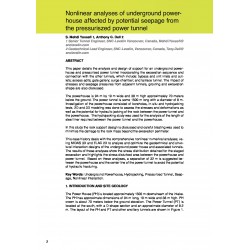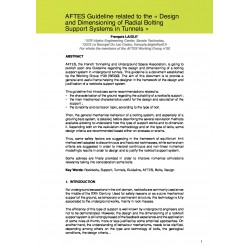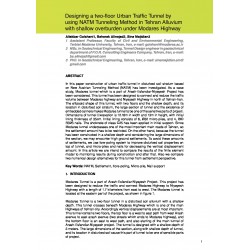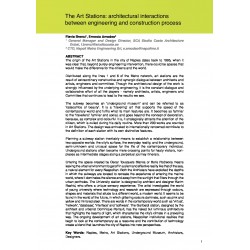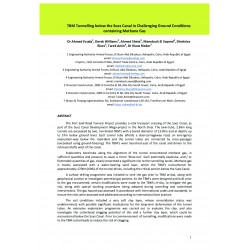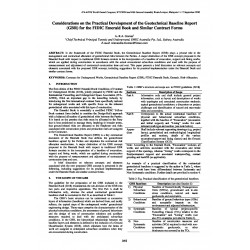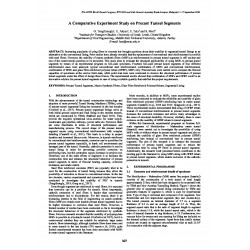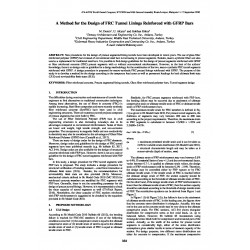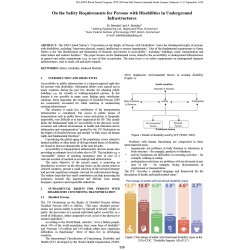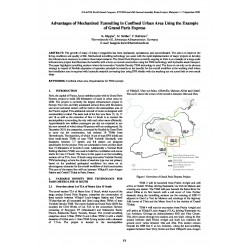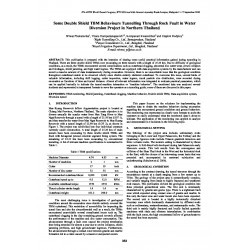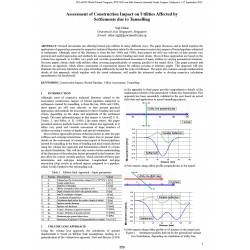No document
Search & filter
Search for a publication
Search & filter
World Tunnelling Congress
WTCThere are 1984 documents.
-
Nonlinear analyses of underground power house affected by potential seepage from the pressuriszed power tunnel
Abstract: This paper details the analysis and design of support for an underground powerhouse and pressurized power tunnel incorporating the excavation sequence and connection with the other tunnels, which include: bypass and unit inlets and outlets; access adits; gate gallery; surge chamber; and tailrace tunnel. The impact of stresses and seepage pressures from adjacent tunnels, grouting and excavation...
0,00 € -
Assessment Of Tunnel Construction Possibilities In Deep High Squeezing Permo-Carboniferous Ground
Abstract: The base tunnels crossing the Karavanke mountain range, located at the border between Austria and Slovenia, have a rich history in finding a proper tunnel construction methodology. Both, railway tunnel, constructed in 1906, and road tunnel, constructed in 1991, faced the most difficult conditions in extremely weak Permo-carboniferous rocks with overburden between 500 m and 1100 m. Such rock...
0,00 € -
AFTES Guideline related to the « Design and Dimensioning of Radial Bolting Support Systems in Tunnels »
Abstract: AFTES, the French Tunnelling and Underground Space Association, is going to publish soon one Guideline regarding the design and dimensioning of a bolting support system in underground tunnels. This guideline is a document established by the Working Group n°30 (WG30). The aim of this document is to provide a general and useful frame helping the designer in the framework of the design and...
0,00 € -
Designing a two-floor Urban Traffic Tunnel by using NATM Tunneling Method in Tehran Alluvium with shallow overburden...
Abstract: In this paper construction of urban traffic tunnel in disturbed soil stratum based on New Austrian Tunneling Method (NATM) has been investigated. As a case study, Modares tunnel which is a part of Arash-Esfandiar-Niyayesh Project has been considered. This tunnel has been designed to connect and reduce the traffic volume between Modares highway and Niyayesh Highway in north of Tehran-Iran. The...
0,00 € -
The Art Stations: architectural interactions between engineering and construction process
Abstract: The origin of the Art Stations in the city of Naples dates back to 1995, when it was clear that, beyond purely engineering intervention, there could be spaces that would make the difference for the citizens and the world.Distributed along the lines 1 and 6 of the Metro network, art stations are the result of extraordinary constructive and synergic dialogue between architects and artists,...
0,00 € -
TBM Tunnelling below the Suez Canal in Challenging Ground Conditions containing Methane Gas
Abstract: The Port Said Road Tunnels Project provides a vital transport crossing of the Suez Canal, as part of the Suez Canal Development Mega-project in the North Sinai. The twin-tube, 2.8km long tunnels are excavated by two, mix-Shield TBM’s with a bored diameter of 13.05m and at depths up to 57m below ground level. Each tunnel tube affords a dual-carriageway road, an emergency evacuation-way below the...
0,00 € -
Performance of Raise Boring Machine (RBM) in Low to Moderately Hard Hornfels Rocks: A case Study of Efemcukuru Gold...
Abstract: Raise Boring Machine (RBM) provides a safe means of excavating a circular hole between two levels without the use of explosives. These machines were developed for the underground mining industry but nowadays is increasingly used on infrastructural projects. This paper aimed to assessment of the performance of a RBM during drilling / excavation of a ventilation shaft in the Efemcukuru Gold Mine,...
0,00 € -
Considerations on the Practical Development of the Geotechnical Baseline Report (GBR) for the FIDIC Emerald Book and...
Abstract: In the framework of the FIDIC Emerald Book, the Geotechnical Baseline Report (GBR) plays a pivotal role in the management and contractual allocation of geotechnical risks between the Parties. A major distinction of the GBR concept proposed in the Emerald Book with respect to traditional GBR formats consists in the incorporation of a baseline of excavation, support and lining works, which are...
0,00 € -
Tunnel Shotcrete Linings - Recent Experiences from Design and Certification of Tunnels in Sydney, Australia
Abstract: The paper presents a critical review and discussion of the design methodologies and technical standards applied for the design of tunnel shotcrete linings of several major recent underground infrastructure projects in Sydney, including both urban road and railway metro tunnels. By being involved in these multiple projects in either the role of the Designer or Independent Checker/Certifier, this...
0,00 € -
A Comparative Experiment Study on Precast Tunnel Segments
Abstract: Increasing popularity of using fibres in concrete has brought questions about their usability in segmental tunnel linings as an alternative to the conventional lining. Prior studies have already revealed that the replacement of conventional steel reinforcement is possible with steel fibres. However, the usability of macro-synthetic fibres (MSFs) as reinforcements in precast tunnel segments is...
0,00 € -
A Method for the Design of FRC Tunnel Linings Reinforced with GFRP Bars
Abstract: New procedures for the design of precast segmental lining tunnels have been developed in recent years. The use of glass fiber reinforced polymer (GFRP) bars instead of conventional steel bars is increasing in precast segments. Besides, macro-synthetic fibers are also used as a replacement for traditional steel bars. It is possible to find design guidelines for the design of precast segments...
0,00 € -
On the Safety Requirements for Persons with Disabilities in Underground Infrastructures
Abstract: The 2008 United Nation’s “Convention on the Rights of Persons with Disabilities” states the fundamental rights of persons with disabilities, including “long-term physical, mental, intellectual or sensory impairments”. One of the fundamental requirements to States Parties is the “the identification and elimination of obstacles and barriers to accessibility”, including “buildings, roads,...
0,00 € -
Advantages of Mechanized Tunnelling in Confined Urban Area Using the Example of Grand Paris Express
Abstract: The growth of many of today’s megacities has been unplanned, spontaneous and uncoordinated. The aim is to improve the living conditions and quality of life. Mechanized tunnelling technology can assist with the rapid implementation of major projects to develop the infrastructure necessary to achieve these improvements. The Grand Paris Express currently ongoing in Paris is an example of a...
0,00 € -
Is A Full Face Drive Safer and More Effective Than Sequential Excavation in Mixed Ground?
Abstract: It is necessary of some adequate instruments to stabilize the face and excavated tunnel wall when tunnelling passes through difficult ground. There are many authors who investigate the instruments (e.g., face bolts and canopies) to stabilize the face and excavated tunnel wall. But the horizontal surface was used in their models of the analyses. Cheung Shan Tunnel in Hong Kong passes through...
0,00 € -
Some Double Shield TBM Behaviours Tunnelling Through Rock Fault in Water Diversion Project in Northern Thailand
Abstract: This publication is prepared with the intention of sharing some useful practical information gained during tunneling in Thailand. There are three double shield TBMs now excavating on three tunnels with a length of 25.26 km. Due to difficulty of geological conditions, as a result, the TBMs encountered several complications such as cutterhead clogging, abnormal disc cutter wear, crown collapses...
0,00 € -
Assessment of Construction Impact on Utilities affected by Settlements due to Tunnelling
Abstract: Ground movements are affecting buried pipe utilities in many different ways. The paper discusses and in detail explains the application of approaches presented in respective technical literature related to the assessment construction impact of buried pipelines subjected to settlements. Although, most of this literature is from the late 1980s and 1990s, these papers are still very relevant, as...
0,00 €

